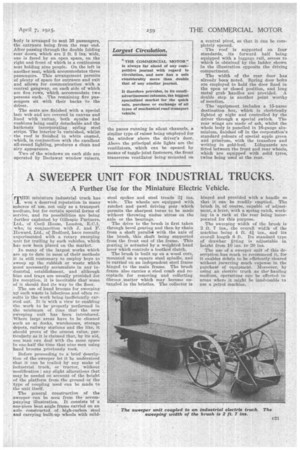A SWEEPER UNIT FOR INDUSTRIAL TRUCKS.
Page 25

If you've noticed an error in this article please click here to report it so we can fix it.
A Further Use for the Miniature Electric Vehicle.
,r • MITE miniature industrial truck has I J_. won a deserved reputation in many spheres of use, not only as a transport medium, but for certain special forms of service, and its possibilities are being further exploited by Gillespie Partners, Ltd., of Cecil House, London, E.C.1, who, in conjunction with J. and F. Howard, Ltd., of Bedford, have recently experimented with a rotary sweeping unit for trailing by such vehicles, which has now been placed on the market.
In many of the largest works which are up to date in most of their methods it is still customary to employ boys to sweep up the rubbish or waste which must necessarily accumulate in any industrial establishment, and although bins and trays are usually provided for its reception, it is inevitable that some of it should find its way to the floor.
The use of hand brooms for sweeping up such waste is laborious and often reSuits in the work being inefficiently carried out. It is with a view to enabling the work to be properly performed in the minimum of time that the new sweeping unit has been introduced. Where large areas have to be cleaned such as at docks, warehouses, storage depots, railway stations and the like, it should prove of the utmost value, particularly as it is claimed that, by its aid, one man can deal with the same space in one-half the time that nine men using hand brooms previously took.
Before proceeding to a brief description of the sweeper let it be understood that it can be trailed by any make of industrial truck, or tractor, without modification ; any slight alterations that may be needed on account of the height of the platform from the ground. or the type of coupling used can be made to the unit itself.
The general construction of the sweeper can be seen from the accompanying illustration. It consists bf a one-piece bent angle frame carried on an axle constructed of high-carbon steel and carrying built-up wheels with mild steel spokes and steel treads 31 ins. wide. The wheels are equipped with ratchet and pawl driving gear which permits the sharpest turns to he made without throwing undue stress on the axle or the bearings.
The drive to the brush is first taken through bevel gearing and then by chain from a shaft parallel with the axis of the brush, this shaft being supported from the front end of the frame. This gearing is actuated by a weighted hand lever which controls a toothed clutch.
The brush is built up on a wood core, mounted on a square steel spindle, and is carried on an independent steel frame hinged to the main frame. The brush frame also carries a steel comb and receptacle for removing and collecting fibrous _matter which may become entangled in the bristles. The collector is
hinged and provided with a handle so that it can be readily emptied. The brush is, of course, capable of adjustment, a lever, with a spring catch, working in a rack at the rear being incorporated for this purpose.
The sweeping width of the brush is 2 ft. 7 ins., the overall width of the machine being 4 ft. 41 ins., and its overall length 6 ft. Its standard type of drawbar fitting is adjustable in height from 10 ins. to 20 ins.
The use of a sweeper unit of this description has much to recommend it, for it enables debris to be efficiently cleared without incurring much expense in the ptirehas of equipment. Moreover, by using an electric truck as the, hauling medium, operations can be effected in areas where it might be inadvisable to use a petrol machine.




























